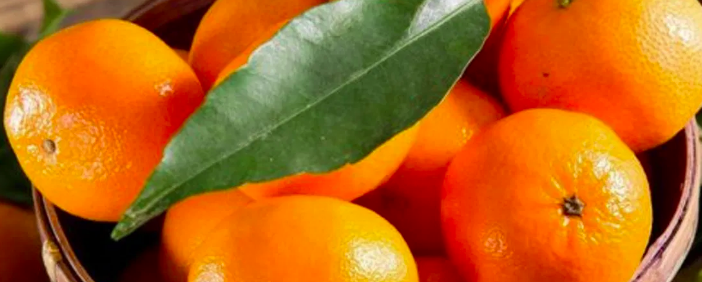
The mandarin is a citrus native to Southeast Asia. The mandarin tree is the mandarin tree, a tree in the Rutacae family. It is a small round and slightly flattened fruit with a diameter of 5 to 9 cm. Its bark is fine, of an orange-red color. Its sweet and fragrant flesh is one of the least acidic among citrus fruits, but it has many seeds.
The health benefits of tangerine:
- Rich in vitamin C
- Rich in antioxidants
- Rich in carbohydrates
- Low calorie
- Strengthens the immune system
What is a tangerine?
Mandarin Identity Card
- Type: Citrus;
- Season: October to March.
- Family: Rutaceae;
- Origin: Southeast Asia
- Color: Orange red
- Flavor: Sweet, fragrant and slightly acidic.
- Features of mandarin
The mandarin is a spherical fruit from 5 to 8 centimeters in diameter. When it is harvested, the mandarin is made up of a thin red-orange bark and juicy, sweet and fragrant flesh. The flesh is divided into ten quarters and contains seeds.
Differences between tangerine and clementine
Clementine, unlike tangerine, is a hybrid obtained by crossing a sweet orange and tangerine. The mandarin contains fewer seeds, has a thinner skin that is easily detached and has a more acidic and less sweet flesh than the clementine.
Word from the nutritionist
According to the National Health Nutrition Program, it is advisable to eat 5 fruits and vegetables per day. Two tangerines represent a portion of fruit. It is better to consume them raw, in quarter, to take advantage of their benefits.
Nutritional values
For 100g of mandarin:
| Nutrients | Quantities |
| Protein | 0.8g |
| Fat | 0.19 g |
| Carbohydrates | 11.9g |
| Water | 86.6g |
| Fibers | 1.7g |
| Vitamin C | 18.7 mg |
| Iodine | 13 µg |
| Calcium | 17.9 mg |
| Potassium | 147 mg |
11 benefits of tangerine: why eat it?
- Tangerine is an excellent source of vitamin C. Eating mandarins will then help stimulate the immune system and fight against fatigue such as cold snaps in winter.
- Tangerine is rich in flavonoids, antioxidant components that help fight against free radicals, responsible for aging skin and many pathologies. .
- The mandarin contains carbohydrates assimilated to sugars which bring energy quickly to the body.
- Poor in lipids and proteins, the mandarin is a fruit with a low caloric intake which is very suitable for people who wish to lose weight.
- Its low fiber content, which is in addition to soluble fiber, makes it a very interesting ally to limit the level of cholesterol in the blood.
- Finally, the mandarin is rich in iodine, calcium and potassium, which are very important for health.
- Thanks to the soluble fibers it contains, the mandarin stimulates digestion gently and reduces digestive disorders.
- These same fibers help regulate the cholesterol and triglyceride levels in the blood. Eating tangerines thus contributes to the prevention of cardiovascular diseases and limits the risks of atherosclerosis.
- Mandarin would prevent certain cancers. The consumption of citrus fruits would reduce the risks of cancers of the mouth, pharynx and digestive tract thanks to the antioxidants they contain;
- Thanks to the carotenoids which will stimulate the production of bone cells and stimulate the absorption of calcium, the mandarin is excellent for your bones.
- Finally the mandarin would have an anti-inflammatory effect thanks to the flavonoids it contains
Choosing the right mandarin
There are different varieties of mandarin and a multitude of recipes to make with this fruit.
The different varieties
There are many varieties, generally classified into six groups, including the very fragrant common mandarin, hence its Latin name Citrus deliciosa, also called de Blidah (in Algeria) or Eze (village above Nice) . Originally from Japan, satsuma has been acclimatized in Spain. It is eaten before the orange coloring of its thin skin which comes off very easily.
Preservation of mandarin
The mandarin keeps for about a week at room temperature. You can double its storage time by placing it in the vegetable drawer of the refrigerator.
Tangerine preparation
How to cook it? How to match it?
Mandarin is cooked like orange:
- Pressed in juice, alone or with other fruits;
- Added to a fruit salad by previously removing the skin covering the quarters;
- The zest comes with a vinaigrette sauce or mayonnaise;
- You can also make jams and mandarin jellies;
- In sauces to accompany seafood or white meats.
History of the mandarin
The tangerine is native to Southeast Asia, China and Japan. It was not imported into Europe and America until the 19th century.
Mandarin is now mainly produced in Spain, Japan, China, Brazil, Korea, Italy, Morocco and other Mediterranean countries. Consumers appreciate them more and more, their production is growing clearly almost everywhere in the world.